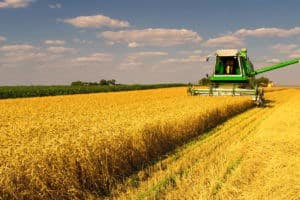2014 saw the long awaited passage of the Farm Bill, which had been stalled for the previous two years in Congress. While not a completely satisfactory agreement for any one group, it marks a rare bipartisan compromise and is worth learning more about as a landowner, outdoor sporting enthusiast, and/or environmentalist.
While the title “Farm Bill,” may not seem explicitly conservation based- this legislation has been the greatest source of private land conservation funding in the United States and promoted vast improvements in land protection and management. A letter sent to the majority leaders and signed by some 230 organizations including the Nature Conservancy, The Wildlife Society, Ducks Unlimited, and the National Wildlife Federation said “it funds programs that improve air and water quality, recharge groundwater aquifers, and create fish and wildlife habitat, thereby providing meaningful benefits to all Americans and taxpayers. Not only do Farm Bill conservation programs play a key role in supporting clean air, clean water and productive soils, they also help producers avoid unnecessary regulation and promote our nation’s long-term economic and food security.”
But what exactly are these measures and how can a landowner go about utilizing them?
There are three main ways that the Farm Bill provides support to landowners.
- Financial Assistance: The farm bill provides funding for landowners through the Environmental Quality Incentives Program (EQIP), the Conservation Stewardship Program (CSP), and the Agricultural Management Assistance Program (AMA). The EQIP helps landowners improve water and air quality, conserve water, reduce erosion, and create, protect, or improve habitat through financial and technical assistance. The CSP pays landowners for their responsible land-management, with higher payments to the higher performers. Finally, the AMA Program helps landowners to construct or improve water management, plant trees, incorporate or advance conservation practices, and even transition to organic farming.
- Easement Programs: The Agricultural Conservation Easement Program (ACEP) combines the former Farm and Ranch Lands Protection Program, Grasslands Reserve Program, and Wetlands Reserve Program. The financial assistance and easements are created to help farmers maintain productive lands, conserve habitat, and protect US food production rather than converting them to other uses. There are different rules for different land types; in certain cases the Natural Resources Conservation Service may pay up to 75% of market value for agricultural easements, up to 100% of the restoration costs for permanent wetland easements.
- Partnerships: The Regional Conservation Partnership Program (RCPP) was developed to facilitate better conservation assistance to producers. This combines the former Agricultural Water Enhancement Program, the Chesapeake Bay Watershed Program, the Cooperative Conservation Partnership Initiative, and the Great Lakes Basin Program. The partners include agricultural associations, cooperatives, governments, American Indian tribes, water treatment entities, conservation NGO’s, and educational institutions who help with funding, implementing, and reporting on conservation practices.
While these are the main three routes that the Farm Bill funding is delivered, there are other programs such as the Agriculture Conservation Experienced Services Program (ACES), which utilizes older and experienced workers from the non-profit conservation sector to help provide technical assistance and Conservation innovation grants which are competitive grants to facilitate research and pilot-project implementation on farms. One that might be of particular interest to you, land owner or not, is the Voluntary Public Access and Habitat Incentive Program (VPA-HIP), which increases public access to private lands for recreational purposes including hunting, fishing, and hiking. The funding provided can be used to expand or improve habitat that is enrolled in public access programs, and other incentives include rental payments or technical services.
The 2014 Farm Bill marks improvement of the conservation and environmentally responsible agenda while ensuring public access to these great spaces. We would be happy to help you evaluate which programs may be appropriate for your own land and how to go about utilizing these tools. You can find more detailed information here.
Written by Field Sport Concepts, Ltd. staff member Macy Anne Carman.
This content may not be used or reproduced in any manner whatsoever, in part or in whole, without written permission of LANDTHINK. Use of this content without permission is a violation of federal copyright law. The articles, posts, comments, opinions and information provided by LANDTHINK are for informational and research purposes only and DOES NOT substitute or coincide with the advice of an attorney, accountant, real estate broker or any other licensed real estate professional. LANDTHINK strongly advises visitors and readers to seek their own professional guidance and advice related to buying, investing in or selling real estate.










Add Comment